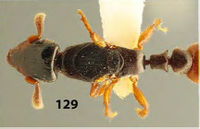Metapone leae
| Metapone leae | |
|---|---|

| |
| Scientific classification | |
| Kingdom: | Animalia |
| Phylum: | Arthropoda |
| Class: | Insecta |
| Order: | Hymenoptera |
| Family: | Formicidae |
| Subfamily: | Myrmicinae |
| Tribe: | Crematogastrini |
| Genus: | Metapone |
| Species: | M. leae |
| Binomial name | |
| Metapone leae Wheeler, W.M., 1919 | |
A Lamington National Park Record implies that M. leae is sympatric there with the Metapone tillyardi.
Identification
Keys including this Species
Distribution
Taylor and Alpert (2016) - Known only from two rain-forested habitats in extreme S.E. Queensland. Probably present also in N.E. NSW, depending on the distribution of termite host species.
Latitudinal Distribution Pattern
Latitudinal Range: -28.207° to -28.207°.
| North Temperate |
North Subtropical |
Tropical | South Subtropical |
South Temperate |
- Source: AntMaps
Distribution based on Regional Taxon Lists
Australasian Region: Australia (type locality).
Distribution based on AntMaps
Distribution based on AntWeb specimens
Check data from AntWeb
Countries Occupied
| Number of countries occupied by this species based on AntWiki Regional Taxon Lists. In general, fewer countries occupied indicates a narrower range, while more countries indicates a more widespread species. |

|
Estimated Abundance
| Relative abundance based on number of AntMaps records per species (this species within the purple bar). Fewer records (to the left) indicates a less abundant/encountered species while more records (to the right) indicates more abundant/encountered species. |

|
Biology
Castes
Nomenclature
The following information is derived from Barry Bolton's Online Catalogue of the Ants of the World.
- leae. Metapone leae Wheeler, W.M. 1919h: 183, figs. 3, 4 (q.) AUSTRALIA (Queensland).
- Type-material: lectotype queen (by designation of Taylor & Alpert, 2016: 536), 21 paralectotype queens.
- Type-locality: lectotype Australia: Queensland, Mt Tambourine (A.M. Lea); paralectotypes with same data.
- Type-depositories: MCZC (lectotype); ANIC, MCZC, SAMA, USNM (paralectotypes).
- Status as species: Gregg, R.E. 1958: 119; Kusnezov, 1960a: 125; Taylor & Brown, 1985: 69; Taylor, 1987a: 40; Taylor, 1991b: 604; Bolton, 1995b: 258; Taylor & Alpert, 2016: 536 (redescription).
- Distribution: Australia.
Unless otherwise noted the text for the remainder of this section is reported from the publication that includes the original description.
Description
Queen
Taylor and Alpert (2016) - (Smallest Lamington N.P. specimen, lectotype): TL: 7.05, 6.93; HL: 1.48, 1.56; HW: 1.15, 1.18; CI: 78, 76; CpL: 0.58, 0.58; CpI: 39, 37; MSL: 2.15, 2.29; ScW: 0.99, 0.98; PetL: 0.49, 0.52; PetW: 0.50, -; PetH: - , 0.58; PpetL: 0.51, -; PpetW: 0.61, -; PpetH: -, 0.68; GW: 1.16, 1.14. The three head-intact ANIC paralectotypes have HW values 1.16–1.19 and CI values of 72–75, and the second Lamington N.P. specimen has HW 1.14, CI 76.
General and diagnostic features as illustrated and keyed here, and in Wheeler’s detailed (1919b) description and figures. Readily identified in the key to Australian species above. M. leae is one of the most peculiarly recognizable of all known Metapone species by virtue of its uniquely flattened head and mesosomal profiles, laterally directed clypeal denticles, unusually constituted petiolar node (with the dorsum raised well above the level of the posterolateral denticles, the latter posterolaterally directed, and the posterior border in dorsal view between the denticles narrowly, medially convex and bilaterally concave, and the very reduced subpetiolar configuration. These characters will, we expect, be present also in the worker caste. The frontal carinae are densely translucent, so that in full frontal view the antennal bases can be faintly seen beneath.
Type Material
Taylor and Alpert (2016) - Gyne: Tamborine Mountain [27S, 153E], Queensland.
Specimens from the type series (syntypes, labelled as “cotypes” by Wheeler) have been examined from the following collections: ANIC (7 specimens on 4 pins), MCZC (2; 1), USNMNH (1). Wheeler reported 22 specimens in the original series. All but one of the ANIC examples are damaged or fragmentary. One of the MCZC specimens is here designated lectotype, and the remaining specimens paralectotypes (all appropriately labelled). An intact type-compared Lamington National Park specimen is illustrated. It was originally alate. Its wings were removed to facilitate photography, and are card-mounted on the specimen pin.
- Syntype, 5 queens, Tamborine Mt. (as Mt. Tambourine), Queensland, Australia, Museum of Comparative Zoology.
References
- Taylor, R. W. and G. D. Alpert, G. D. 2016. The myrmicine ant genus Metapone Forel (Hymenoptera: Formicidae): a global taxonomic review with descriptions of twelve new species. Zootaxa. 4105(6):501-545. [2016-04-27]
- Wheeler, W. M. 1919j. The ants of the genus Metapone Forel. Ann. Entomol. Soc. Am. 12: 173-191 (page 183, figs. 3, 4 queen described)
References based on Global Ant Biodiversity Informatics
- Kusnezov N. 1960. La posición sistemática del género Metapone Forel (Hymenoptera, Formicidae). Acta Zoologica Lilloana 18: 119-126.

